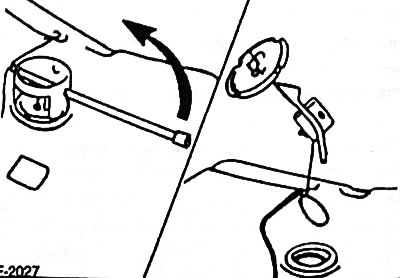The diesel engine has only a fuel level sensor without a fuel pump, the fuel is pumped up by the injection pump.
As the fuel level drops, the float in the fuel tank goes down. In this case, a potentiometer connected to the float increases the resistance of the sensor. As a result, the voltage on the indicating device drops, and the arrow of the fuel gauge on the instrument panel moves in the direction of the leer (empty). Depending on the equipment of the vehicle, when the fuel level drops to the reserve level, an additional warning lamp lights up on the instrument panel.
Attention: No open flames, prepare a fire extinguisher and strictly follow the safety regulations when working on fuel supply systems, see previous chapter.
Withdrawal
Disconnect ground wire (-) battery.
Caution: Disconnecting the battery will erase the contents of the electronic memories, such as engine trouble codes or radio codes. Before switching off, also read the instructions in chapter "Removing and installing the battery".
Remove fuel tank, see next chapter.

Using the FORD special tool 23-014/23-026, turn the holder for the fuel gauge sensor counterclockwise -arrow-. If no tool is available, loosen the probe holder with a pipe wrench or light hammer blows on a piece of hardwood.
Attention: No sparks should be produced, otherwise a fire may occur.
Pull the level sensor holder up, tilt to the side and remove. In this case, it is necessary to put rags down to absorb the escaping fuel.
Installation
Clean the sealing surfaces of the fuel tank and the holder of the fuel level sensor from rust and dirt.
Caution: No contaminants must enter the fuel tank.
Attach the fuel level sensor holder with a new seal.
Tighten the fuel gauge holder in a clockwise direction.
Install fuel tank, see next chapter.
Connect ground wire to battery (-).
If available, set the clock and enter the anti-theft code for the radio.
Check the operation of the fuel gauge on the instrument panel.
Visitor comments